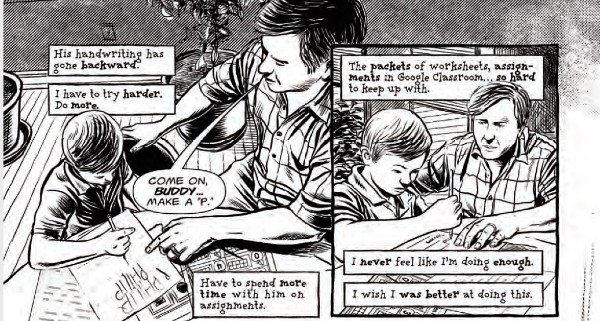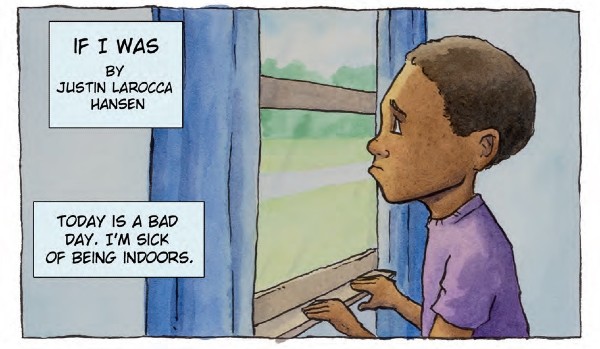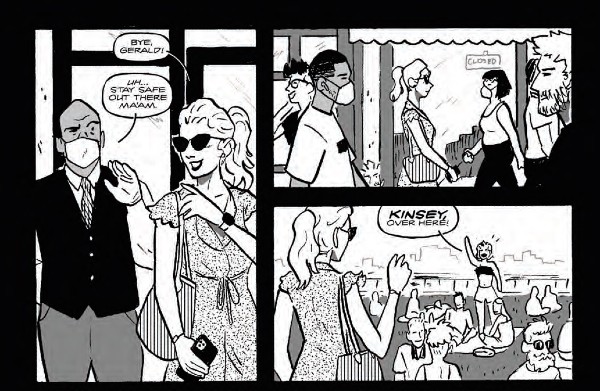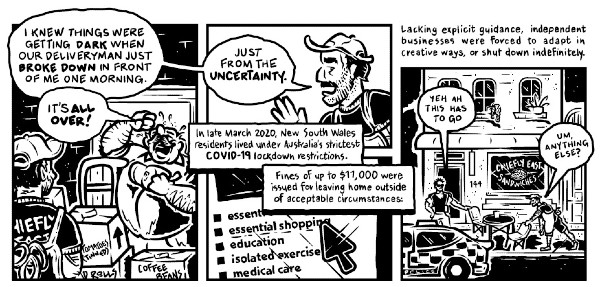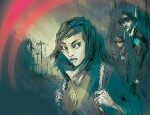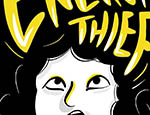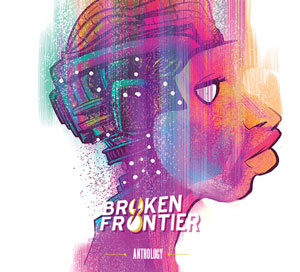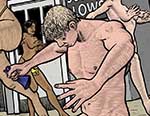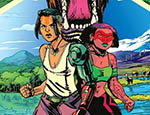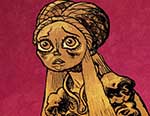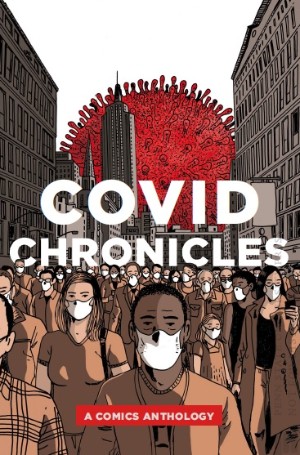 What can you say about COVID-19? The ongoing pandemic has been the first thing on just about everyone’s minds for almost a year now, the absences and changes to “normal life” becoming omnipresent. It has endured long enough that artworks have started to respond to it, with comics some of the most responsive. COVID Chronicles is an anthology collection of 64 short comics to detail response to Coronavirus, running a spectrum of theme, content, style and tone. For the editors understand there is not one thing to say about COVID-19, but several.
What can you say about COVID-19? The ongoing pandemic has been the first thing on just about everyone’s minds for almost a year now, the absences and changes to “normal life” becoming omnipresent. It has endured long enough that artworks have started to respond to it, with comics some of the most responsive. COVID Chronicles is an anthology collection of 64 short comics to detail response to Coronavirus, running a spectrum of theme, content, style and tone. For the editors understand there is not one thing to say about COVID-19, but several.
Some creators use the infographic nature of comics to tackle COVID-19 head-on. Wielding the sub-genre of “graphic medicine”, they present an analytical overview of previous viral outbreaks (‘Past Pandemics’ by Ned Barnett), the polio vaccine (‘The Iron Lung at the Enders Lab’ by Katy Doughty), or even the prevalent totem of the Japanese spirit Amabi, invoked in artwork during times of distress (‘Yokai Parade presents Amabie!’ by Zack Davisson and Lili Chin). Such “documentary” accounts examine precedents and history, often as a way of informing readers how such emergencies have happened before.
Often the tales are far more personal and immediate, down to ‘COVID-19 Diary’ by Jason Chatfield opening the anthology, running through Chatfield’s symptoms after he contracted the virus. The 13-page story – one of the longest in COVID Chronicles, albeit largely due to single-page panels – sets the serious stakes of the anthology, even if Chatfield’s recollections are largely tongue-in-cheek. Other testimonies range from anger at public irresponsibility (‘Apocalypse of Ignorance’ by Seth Tobocman and Tamara Tornado; ‘Epitaph for Myself’ by Rivi Handler-Spitz), to grief from losing loved ones (‘Grief Changes’ by Shelley Wall; ‘And This Is How I Leave You’ by Sean Seamus McWhinny). But often the strips are more quotidian tales of people adjust to a new way of life. These include lyrical contemplations, like ‘Meditations’ by Gerry Chow, that features introspective prose layered over gorgeous still-life sketch-work. Or realistic overviews like ‘Lessons Learned’ (below), showing the frustrations and adaptations of Tim E. Ogline working from home, especially while raising a young son.
Dealing with kids is a common theme in COVID Chronicles. The pandemic highlighted the vulnerability of elder relatives, but it also left parents uncertain how to ease their kids into drastically different circumstances (especially when they know so little themselves). ‘Ripples’ by Amy and Brian Canini is a melancholy cartoon about two young daughters confused and saddened about their lives suddenly being suspended, even if they eventually lean upon their family. ‘PAW Patrol to the Rescue’ also meditates on how Sage Stossel’s young son is reacting to the news, potentially hoping for “rescue from above by powerful figures in charge. A childish fantasy perhaps. But who among us can’t relate?”. Indeed, sometimes COVID Chronicles will apply a kid-friendly filter around current events, cloaking them as a fantastical adventures so that children can comprehend it better (‘If I Was’ – below – by Justin LaRocca Hansen; ‘Protecting Simmons Base’ by Armond Boudreaux and Ignacio Di Meglio), albeit with a clear awareness that COVID-19 is no game.
Indeed, many stories in COVID Chronicles remind us that the virus is no great leveller. The pandemic has frequently exposed and amplified the disproportionate structures embedded in our society, the disparities in the way people work and live now becoming directly life-threatening. ‘Eviction’ shows the tragic tale of Eiri J. Brown being evicted during the pandemic, while ‘Two Weeks Notice’ by Mark Heinrichs gives a geometric perspective of how the initial gestures of support by governments and landlords quickly evaporated as the pandemic became more long-term. Of course, 2020 also saw renewed surges of Black Lives Matter protests following the murder of George Floyd, and this continued racial discrimination inevitably filtered down to the pandemic. ‘The Right to Breathe’ by Maureen Burdock and Joanna Regulska directly tied these twin issues together, indicting poor leadership (by Trump, Obrador and Bolsanaro) compared to positive examples (by Arden, Tasi, Merkel), and formulating a rallying cry for change. ‘Between Two Worlds’ by Julio Anta, Jacoby Salcedo and Hassan Otsmane-Elhaou (below) also elucidates parallel treatments of the pandemic, contrasting privileged white New Yorkers who complain about lockdown’s inconvenience (and are coddled by the authorities), and teenagers of colour who are harassed by the police despite being far more sensible.
Even amidst the despair and discrimination, COVID Chronicles attempts to eke out some hope. Sometimes disparate communities have rallied together, like Native Americans gathering for an online powwow dance in ‘How to Have a Powwow in a Pandemic’ by S.I. Rosenbaum and Arigon Starr. In ‘Wartime Haircut’ (below), Ben Mitchell explains how a family-run sandwich shop managed to reorganise itself into a take-away community hub that became a beacon of light. Mitchell asks if things have to “go back to how [they] were”, and if things cannot evolve and pivot into something better instead. ‘Small Acts’ by Stephanie Nina Pitsirilos and Seth Martel quietly asks something similar, gently observing the small communal gestures neighbourhoods make to (literally, via creative graffiti) add colour to each other’s lives. And maybe, for those fortunate enough to have security and support, the pandemic provides an opportunity to reflect and participate in the everyday family activities previously taken for granted, as they do in the short and sweet cartoon ‘Puzzling Together’ by Kelly Latham.
COVID Chronicles contains an almost overwhelmingly vast collection of stories, the compilation of which builds into a substantial documentation of experiences under Coronavirus. The editors (Kendra Boileau and Rich Johnson) do impressive work in sequencing these tales, the ordering gracefully flowing between each topic and tone. Honestly I’m unsure if there’s any revelatory said about COVID here, or if there’s much to be gained from looking at it so directly. I couldn’t blame anyone uninterested in owning yet another reminder of this awful international crisis. Yet COVID Chronicles is still worthwhile in its task to record the responses and reactions to this historic year. As a taxonomy of the many voices around the pandemic, COVID Chronicles is a substantial and wide-ranging anthology.
Jason Chatfield, Jesse Lambert, Emily Steinberg, Ajuan Mance, Rivi Handler-Spitz, Katy Doughty, Ned Barnett, Seth Tobocman & Tamara Tornado, Laura Holzman, Sean Seamus McWhinny, Brenna Thummler, Janet K. Lee, Joe Decie, Gerry Chow, Shelley Wall, Luis Manriquez & Simon Gentry, Kang Jing and Pavith C., Tim E. Ogline, Mark Heinrichs, Comic Nurse (MK Czerwiec), Zack Davisson & Lili Chin, S.I. Rosenbaum & Arigon Starr, Tom K. Mason, Eduardo Garcia, Kurt Hathaway & Chris Summers, Sage Stossel, Lee Marrs, Justin LaRocca Hansen, Maureen Burdock and Joanna Regulska, Gene Ambaum & Willow Payne, Stephanie Nina Pitsirilos & Seth Martel, Armond Boudreaux & Ignacio Di Meglio, Kelly Latham, Brian Canini & Amy Canini, Scott J. Jones, Ben Mitchell, Rob Kirby, Rob Kraneveldt and Mike Garcia, Peter Dunlap-Shohl, Sarah Firth, Quincy Scott Jones, Ken Best & Zen, Julio Anta, Jacoby Salcedo & Hassan Otsmane-Elhaou, Aa Roland Burkart & Natascha Hoffmeyer, Rich Johnson & Eli Neugeboren, Kendra Boileau, Jazmine Joyner & John Jennings, Jay Stephens, Hatiye Garip • Graphic Mundi, $21.95
Review by Bruno Savill de Jong





